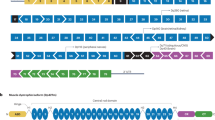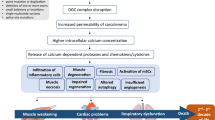Abstract
The outstanding advances in the molecular characterization of muscle diseases, including muscular dystrophies, inflammatory myopathies, and ion channel disorders, have resulted in the identification of potential targets for pharmacologic and genetic therapy in the best characterized of these diseases. The most common myopathy in children, Duchenne muscular dystrophy (DMD), is the focus of active pharmacologic clinical trials. Genetic transfer therapy research for this and other dystrophies is rapidly moving forward. However, as new approaches for treatment are being actively investigated, the current modality of treatment for all myopathies is still in the realm of physical medicine and rehabilitation. The focus of this review is on the advances in pharmacologic and genetic therapy research in DMD and limb girdle muscular dystrophies.
Similar content being viewed by others
References and Recommended Reading
Koenig M, Hoffman EP, Bertelson CJ, et al.: Complete cloning of the Duchenne muscular dystrophy (DMD) cDNA and preliminary genomic organization of the DMD gene in normal and affected individuals. Cell 1987, 50:509–517.
Hoffman EP, Brown RH Jr., Kunkel LM: Dystrophin: the protein product of the Duchenne muscular dystrophy locus. Cell 1987, 51:919–928.
Granchelli JA, Pollina C, Hudecki MS: Pre-clinical screening of drugs using the mdx mouse. Neuromuscul Disord 2000, 10:235–239. This paper shows the results of a large-scale pharmacologic trial in the mdx mouse model of Duchenne muscular dystrophy.
Bakker JP, de Groot IJ, Beckerman H, et al.: The effects of knee-ankle-foot orthoses in the treatment of Duchenne muscular dystrophy: review of the literature. Clin Rehabil 2000, 14:343–359.
Gozal D: Pulmonary manifestations of neuromuscular disease with special reference to Duchenne muscular dystrophy and spinal muscular atrophy. Pediatr Pulmonol 2000, 29:141–150.
Gozal D, Thiriet P: Respiratory muscle training in neuromuscular disease: long-term effects on strength and load perception. Med Sci Sports Exerc 1999, 31:1522–1527.
Simonds AK, Muntoni F, Heather S, Fielding S: Impact of nasal ventilation on survival in hypercapnic Duchenne muscular dystrophy [comment]. Thorax 1998, 53:949–952.
Hoffman EP, Monaco AP, Feener CC, Kunkel LM: Conservation of the Duchenne muscular dystrophy gene in mice and humans. Science 1987, 238:347–350.
Gorospe J, Nishikawa B, Hoffman E: Pathophysiology of dystrophin deficiency: a clinical and biological enigma. In Dystrophin: Gene, Protein, and Cell. Edited by Lucy JA. Cambridge: Cambridge University Press; in press. Excellent review of the current knowledge on Duchenne muscular dystrophy pathophysiology
Floyd SS Jr., Clemens PR, Ontell MR, et al.: Ex vivo gene transfer using adenovirus-mediated full-length dystrophin delivery to dystrophic muscles. Gene Ther 1998, 5:19–30. This approach uses myoblasts infected with AAV carrying the dystrophin gene. Good expression is achieved, although cellular response is elicited.
Ohtsuka Y, Udaka K, Yamashiro Y, et al.: Dystrophin acts as a transplantation rejection antigen in dystrophin-deficient mice: implication for gene therapy. J Immunol 1998, 160:4635–4640.
Xiao X, Li J, Tsao YP, et al.: Full functional rescue of a complete muscle (TA) in dystrophic hamsters by adeno-associated virus vector-directed gene therapy. J Virol 2000, 74:1436–1442. The authors show complete functional recovery of the dystrophic hamster after a gene transfer experiment.
Stedman H, Wilson JM, Finke R, et al.: Phase I clinical trial utilizing gene therapy for limb girdle muscular dystrophy: alpha-, beta-, gamma-, or delta-sarcoglycan gene delivered with intramuscular instillations of adeno-associated vectors. Hum Gene Ther 2000, 11:777–790.
Barton-Davis ER, Cordier L, Shoturma DI, et al.: Aminoglycoside antibiotics restore dystrophin function to skeletal muscles of mdx mice [comment]. J Clin Invest 1999, 104:375–381. The authors show an increase of dystrophin-positive cells (15%) after treating mdx mice with intraperitoneal gentamycin. Gentamycin causes skipping of the stop codon mutation that causes the dystrophic phenotype in this model.
Gramolini AO, Burton EA, Tinsley JM, et al.: Muscle and neural isoforms of agrin increase utrophin expression in cultured myotubes via a transcriptional regulatory mechanism. J Biol Chem 1998, 273:736–743.
Khurana TS, Rosmarin AG, Shang J, et al.: Activation of utrophin promoter by heregulin via the ets-related transcription factor complex GA-binding protein alpha/ beta. Mol Biol Cell 1999, 10:2075–2086.
Gilbert R, Nalbantoglu J, Petrof BJ, et al.: Adenovirus-mediated utrophin gene transfer mitigates the dystrophic phenotype of mdx mouse muscles. Hum Gene Ther 1999, 10:1299–1310. This paper shows the full functional and histologic recovery of the mdx phenotype after utrophin up-regulation by gene transfer experiments.
Brooke MH, Fenichel GM, Griggs RC, et al.: Clinical investigation in Duchenne dystrophy: 2. Determination of the “power” of therapeutic trials based on the natural history. Muscle Nerve 1983, 6:91–103.
Mendell JR, Moxley RT, Griggs RC, et al.: Randomized, doubleblind six-month trial of prednisone in Duchenne’s muscular dystrophy [comment]. N Engl J Med 1989, 320:1592–1597.
Fenichel GM, Florence JM, Pestronk A, et al.: Long-term benefit from prednisone therapy in Duchenne muscular dystrophy. Neurology 1991, 41:1874–1877.
Griggs RC, Moxley RT, Mendell JR, et al.: Duchenne dystrophy: randomized, controlled trial of prednisone (18 months) and azathioprine (12 months) [comment]. Neurology 1993, 43(3 Pt 1):520–527.
Kissel JT, Lynn DJ, Rammohan KW, et al.: Mononuclear cell analysis of muscle biopsies in prednisone- and azathioprinetreated Duchenne muscular dystrophy. Neurology 1993, 43(3 Pt 1):532–536.
Angelini C, Pegoraro E, Turella E, et al.: Deflazacort in Duchenne dystrophy: study of long-term effect [published erratum appears in Muscle Nerve 1994, 17:833]. Muscle Nerve 1994, 17:386–391.
Bonifati MD, Ruzza G, Bonometto P, et al.: A multicenter, double-blind, randomized trial of deflazacort versus prednisone in Duchenne muscular dystrophy. Muscle Nerve 2000, 23:1344–1347. Recent study comparing prednisone and deflazacort side effects. Deflazacort shows decreased incidence of weight gain.
Mesa LE, Dubrovsky AL, Corderi J, et al.: Steroids in Duchenne muscular dystrophy—deflazacort trial. Neuromuscul Disord 1991, 1:261–266.
Sharma KR, Mynhier MA, Miller RG: Cyclosporine increases muscular force generation in Duchenne muscular dystrophy [comment]. Neurology 1993, 43(3 Pt 1):527–532.
Fenichel G, Pestronk A, Florence J, et al.: A beneficial effect of oxandrolone in the treatment of Duchenne muscular dystrophy: a pilot study. Neurology 1997, 48:1225–1226.
Gorospe JR, Hoffman EP: Duchenne muscular dystrophy. Curr Opin Rheumatol 1992, 4:794–800.
Gorospe JR, Tharp MD, Hinckley J, et al.: A role for mast cells in the progression of Duchenne muscular dystrophy? Correlations in dystrophin-deficient humans, dogs, and mice. J Neurol Sci 1994, 122:44–56.
Hankard RG, Hammond D, Haymond MW, Darmaun D: Oral glutamine slows down whole body protein breakdown in Duchenne muscular dystrophy. Pediatr Res 1998, 43:222–226.
Kuznetsov AV, et al.: Impaired mitochondrial oxidative phosphorylation in skeletal muscle of the dystrophindeficient mdx mouse. Mol Cell Biochem 1998, 183(1-2):87–96.
Angelini C, Fanin M, Menegazzo E, et al.: Homozygous alphasarcoglycan mutation in two siblings: one asymptomatic and one steroid-responsive mild limb-girdle muscular dystrophy patient. Muscle Nerve 1998, 21:769–775.
Connolly AM, Pestronk A, Mehta S, Al-Lozi M: Primary alphasarcoglycan deficiency responsive to immunosuppression over three years. Muscle Nerve 1998, 21:1549–1553.
Walter MC, Lochmuller H, Reilich P, et al.: Creatine monohydrate in muscular dystrophies: a double-blind, placebocontrolled clinical study. Neurology 2000, 54:1848–1850.
Author information
Authors and Affiliations
Rights and permissions
About this article
Cite this article
Escolar, D.M., Scacheri, C.G. Pharmacologic and genetic therapy for childhood muscular dystrophies. Curr Neurol Neurosci Rep 1, 168–174 (2001). https://doi.org/10.1007/s11910-001-0013-y
Issue Date:
DOI: https://doi.org/10.1007/s11910-001-0013-y




